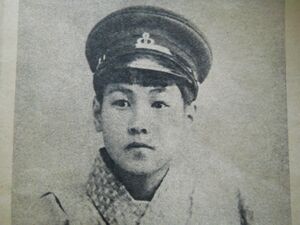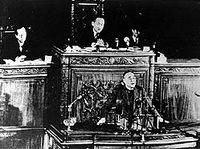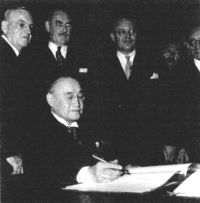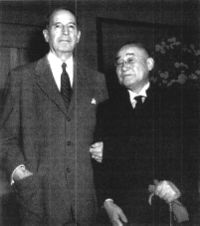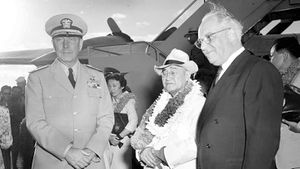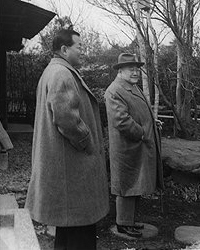شيگىرو يوشيدا
شيگـِرو يوشيدا 吉田 茂 | |
|---|---|
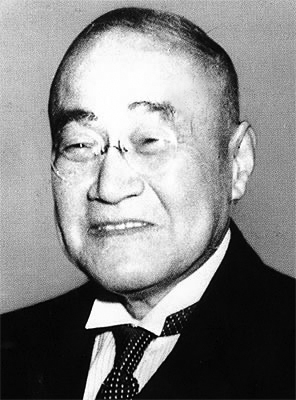 | |
| رئيس وزراء اليابان | |
| في المنصب 22 مايو 1946 – 24 مايو 1947 | |
| العاهل | شووا |
| الحاكم | دوغلاس ماك آرثر |
| سبقه | كيجورو شيديهارا |
| خلـَفه | تتسو كاتاياما |
| في المنصب 15 أكتوبر 1948 – 10 ديسمبر 1954 | |
| العاهل | شووا |
| الحاكم | دوگلاس ماك آرثر ماثيو ريدجواي |
| سبقه | هيتوشي أشيدا |
| خلـَفه | إيتشيرو هاتوياما |
| تفاصيل شخصية | |
| وُلِد | 22 سبتمبر 1878 يوكوسوكا, اليابان |
| توفي | 20 أكتوبر 1967 (aged 89) طوكيو، اليابان |
| الحزب | الحزب الليبرالي الديمقراطي (1955–1967) |
| ارتباطات سياسية أخرى | الحزب الليبرالي (1945–1950) الحزب الليبرالي الديمقراطي (1950–1955) |
| الزوج | Yukiko Yoshida |
| الأنجال | Ken'ichi Yoshida Kazuko Yoshida |
| المدرسة الأم | جامعة طوكيو الإمبراطورية |
| التوقيع |  |
شيگـِرو يوشيدا 吉田 茂 يوشيدا هو اسم العائلة (22 سبتمبر، 1878 - 20 أكتوبر 1967) كان دبلوماسيا يابانيا وسياسيا شغل منصب رئيس وزراء اليابان في الفترة بين 1946 - 1947 وللمرة الثانية بين 1948 - 1954، فكان واحداً من longest-serving Japanese prime ministers, and is the third-longest serving prime minister of post-occupation Japan.[1] كانت سياساته تعمل على تنشيط اليابان بعد الحرب العالمية الثانية بالاعتماد على الولايات المتحدة للحماية العسكرية.
. . . . . . . . . . . . . . . . . . . . . . . . . . . . . . . . . . . . . . . . . . . . . . . . . . . . . . . . . . . . . . . . . . . . . . . . . . . . . . . . . . . . . . . . . . . . . . . . . . . . . . . . . . . . . . . . . . . . . . . . . . . . . . . . . . . . . . . . . . . . . . . . . . . . . . . . . . . . . . . . . . . . . . . .
حياته
ولد يوشيدا في 22 سبتمبر 1878، في Kanda-Surugadai, Tokyo, the fifth son of political activist and former samurai Tsuna Takeuchi.[2][3] Tsuna was a devout supporter of Itagaki Taisuke and would later serve in the first National Diet in 1890. Yoshida's biological mother's identity is not known. Shortly before his birth, his biological father was arrested for anti-government conspiracy, and his mother gave birth to him at the house of Kenzō Yoshida, a friend of his father. As young samurai, Tsuna and Kenzō had made a name amidst the decades of unrest around the time of Meiji Restoration.[3] In August 1881, Yoshida was adopted by Kenzō Yoshida and his wife Kotoko. Kenzō was a wealthy trade merchant, former Jardine Matheson Yokohama branch manager and former samurai,[2] and Kotoko was the daughter of an Edo period Confucian scholar.[3]
Yoshida began his education in a rural boarding school. He graduated elementary school in 1889. That same year, Kenzō Yoshida died, and Shigeru inherited a substantial fortune from him. Kotoko subsequently raised Shigeru on the family's estate in Ōiso. Shigeru finished secondary school in 1894, and attended junior high school until 1895, after which he briefly attended business school. He attended an academy run by the crown prince's ethics tutor in Tokyo, and briefly studied at Keio University and the Tokyo Physics School (now the Tokyo University of Science). He also spent a year ill at home in Ōiso. In 1897, he entered the prestigious Peers' School, which prepared members of the elite for the public service, and was run by Duke Konoe Atsumaro. After completing his education there, Yoshida attended a college for diplomats also run by Duke Atsumaro. Shortly after Atsumaro's death in 1904, the college became defunct, and Yoshida then studied law at Tokyo Imperial University, graduating with a law degree in 1906. He passed the Foreign Service Entry Exam and entered Japan's diplomatic corps that same year, shortly after Japan's victory against Russia in the Russo-Japanese War.[4] He has long been regarded as prioritising the economy over defense, but recent years have seen a reevaluation of this viewpoint.
Diplomatic career
Yoshida's diplomatic career began with a posting in China, first at the Japanese mission in Tianjin in November 1906, then in Fengtian (now Shenyang) in 1907. In 1909, he was assigned to Italy, and in 1912, he was posted to Andong in Japanese-ruled Korea. In 1916, he was assigned to the Japanese embassy in the United States, and in 1918 he was assigned to Jinan, China. In 1919, he was a member of the Japanese legation at the Paris Peace Conference. In 1920, he was named first secretary to the Japanese embassy in the United Kingdom. In 1922, he returned to China and served in Tianjin until 1925, then in Fengtian until 1928.[4]
In 1928, he briefly served as minister to Sweden, Norway, and Denmark before being appointed deputy foreign minister that same year, serving until 1930. In 1930, after the army vetoed his appointment as foreign minister, he was appointed ambassador to Italy, and in 1936, he became ambassador to the United Kingdom, serving until 1938. During the 1930s, he supported increasing Japanese influence in China, and advocated for the independence of Manchuria and Mongolia to weaken the Republic of China. After his ambassadorship to the United Kingdom ended in 1938, he retired from the diplomatic service.[4]
أثناء الحرب العالمية الثانية
Although considered a "hawk" on China, Yoshida was firmly against war with the United States and United Kingdom. Despite holding no official positions during World War II, he was active in trying to prevent war with the Allies, and then to try to bring about an early end of the war, allying himself with Prince Fumimaro Konoe.
Right before the Pacific War began, Yoshida joined Konoe in unsuccessfully attempting to deescalate the situation.[4] During the war, Yoshida continued to associate with Konoe in trying to get the government to negotiate a peace with the Allies. In April 1945, he was arrested and briefly imprisoned over his association with Prince Konoe.
بعد الحرب العالمية الثانية
رئاسته للوزارات
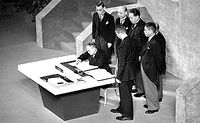
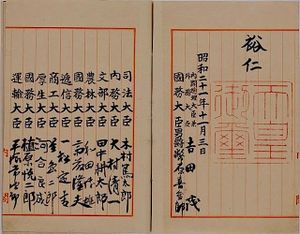
Yoshida became the 45th prime minister on 22 May 1946. His pro-American and pro-British ideals and his knowledge of Western societies, gained through education and political work abroad are what made him the perfect candidate in the eyes of the postwar Allied occupation.
After being replaced with Tetsu Katayama on 24 May 1947, he returned to the post as the 48th prime minister on 15 October 1948.
According to CIA files that were declassified in 2005, there was a 1952 plot to assassinate Yoshida and replace him with Ichirō Hatoyama as Prime Minister. The plot was led by Takushiro Hattori, who served as an Imperial Japanese Army officer, and had the support of 500,000 Japanese.[5]
سياساته
Yoshida's policies, emphasizing Japan's economic recovery and a reliance on الولايات المتحدة military protection at the expense of independence in foreign affairs, became known as the Yoshida Doctrine and shaped Japanese foreign policy during the Cold War era and beyond.[6]
Under Yoshida's leadership, Japan began to rebuild its lost industrial infrastructure and placed a premium on unrestrained economic growth. Many of these concepts still impact Japan's political and economic policies. However, since the 1970s environmental movement, the bursting of Japan's economic bubble, and the end of the Cold War, Japan has been struggling to redefine its national goals.
He was retained in three succeeding elections (49th: 16 February 1949; 50th: 30 October 1952; and 51st: 21 May 1953). Power slipped away as he was ousted on 10 December 1954, when he was replaced by Ichirō Hatoyama.
Yoshida retired from the Diet of Japan in 1963.
آخر العمر
في 1967, Yoshida was baptized on his deathbed after hiding his Catholicism throughout most of his life. His funeral was held in St. Mary's Cathedral, Tokyo.
Yoshida's grandchildren are Princess Tomohito of Mikasa and Tarō Asō, a Japanese politician who served as the 92nd Prime Minister of Japan from 2008 to 2009.
الهامش
- ^ "連続在職日数、安倍首相2位に 第2次内閣から2248日(共同通信) - Yahoo!ニュース". Archived from the original on 2019-02-23. Retrieved 2019-02-22.
- ^ أ ب Jitsuroku shushō retsuden : Kuni o ninatta otokotachi no honkai to satetsu. 学習研究社. 2003. p. 98. ISBN 4-05-603151-7. OCLC 676126154.
- ^ أ ب ت Yoshida Shigeru to sono jidai. Genji Ookubo, John W. Dower, 愿二大窪. 中央公論社. 1991. pp. 5, 6. ISBN 9784122018327. OCLC 1021037693.
{{cite book}}: CS1 maint: others (link) - ^ أ ب ت ث "Shigeru Yoshida".
- ^ "CIA Papers Reveal 1950s Japan Coup Plot". Associated Press. 28 February 2007. Retrieved 11 August 2015 – via HighBeam Research.
{{cite web}}: Unknown parameter|subscription=ignored (|url-access=suggested) (help) - ^ Beeson, Mark. (2001). "Japan and Southeast Asia: The Lineaments of Quasi-Hegemony," p. 4 of linked e-reprint, citing Pyle, Kenneth B. (1998) "Restructuring Foreign Policy and Defence Policy: Japan," in McGrew, A. et al. (1998). Asia-Pacific in the New World Order, pp. 121–36.
وصلات خارجية
| مناصب سياسية | ||
|---|---|---|
| سبقه Mamoru Shigemitsu |
وزير الشئون الخارجية 1945–1947 |
تبعه Hitoshi Ashida |
| سبقه Kijūrō Shidehara |
رئيس وزراء اليابان 1946–1947 |
تبعه تتسو كاتاياما |
| سبقه Hitoshi Ashida |
وزير الشئون الخارجية 1948–1954 |
تبعه Mamoru Shigemitsu |
| رئيس وزراء اليابان 1948–1954 |
تبعه Ichirō Hatoyama | |
| هل أنت مهتم باليابان؟ ستجد الكثير من المعلومات في بوابة اليابان. |
- CS1 maint: others
- CS1 errors: unsupported parameter
- Short description is different from Wikidata
- Pages using infobox officeholder with unknown parameters
- مقالات تحتوي نصاً باللغة اليابانية
- بذرة أعلام اليابان
- جميع المقالات المتعلقة باليابان
- مواليد 1878
- وفيات 1967
- دبلوماسيون يابانيون
- أشخاص من طوكيو
- أشخاص من محافظة كوتشي
- خريجو جامعة گاكوشوئين
- خريجو جامعة طوكيو
- سفراء اليابان إلى إيطاليا
- سفراء اليابان إلى المملكة المتحدة
- Members of the House of Peers
- Members of the House of Representatives of Japan
- وزراء خارجية اليابان
- رؤساء وزراء اليابان
- شخصيات الحرب الكورية
- قادة الحرب الباردة
- Japanese anti-communists
- Japanese Roman Catholics
- Knights Commander of the Royal Victorian Order
- Liberal Party (Japan, 1945) politicians
- Liberal Democratic Party (Japan) politicians

